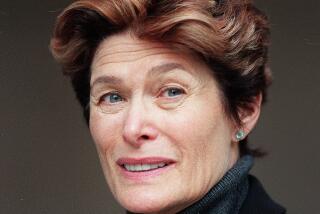Eugene Aserinsky; Co-Discoverer of REM
- Share via
Eugene Aserinsky, 77, the scientist who co-discovered the rapid eye movement cycle of sleep. In 1952, he was a researcher at the University of Chicago when he and Nathaniel Kleitman identified what is commonly referred to by its initials: REM. The existence of REM, which has been found to average about 22% of total sleep time, showed that the brain was in an active waking state during sleep rather than in the previously believed state of repose. Aserinsky later headed the department of physiology and pharmacology at Marshall University in Huntington, W.Va. He lived in Escondido during his retirement. On Wednesday in La Costa, Calif., after an automobile accident.
O’Landa Draper; Gospel Choir Director
For the record:
12:00 a.m. Aug. 14, 1998 For the Record
Los Angeles Times Friday August 14, 1998 Home Edition Part A Page 30 Metro Desk 2 inches; 70 words Type of Material: Correction
Aserinsky discovery--A brief obituary of Eugene Aserinsky in The Times on July 25 identified him as the co-discoverer, along with Nathaniel Kleitman, of the rapid eye movement (REM) cycle of sleep. Emaline Rich, Aserinsky’s first cousin, said that Aserinsky made the discovery alone when he was a graduate student at the University of Chicago. She said that Kleitman was listed as co-author of the research paper only because Kleitman was the professor supervising Aserinsky’s doctoral thesis.
O’Landa Draper, 34, prominent gospel choir director and five-time Grammy nominee. A native of Memphis, Tenn., he headed his first choir while he was in high school, eventually directing the gospel choir at Memphis State University. At 22, he formed the Associates. The choir’s performances, distinguished by enthusiastic choreography and precise vocals, greatly influenced other gospel choirs, such as Kirk Franklin & the Family and God’s Property, which borrowed those elements and found commercial success. Although such success eluded O’Landa Draper & the Associates, the 60-member choir recorded six albums and backed such popular performers as Shirley Caesar, Billy Joel, Yolanda Adams and Jennifer Holliday. The Dove Award-winning group’s latest CD, “Reflections,” reached No. 10 on Billboard magazine’s gospel chart earlier this year. Draper was also a board member of the Memphis chapter of the National Academy of Recording Arts and Sciences. On Tuesday in Nashville of kidney failure.
Mark Hampton; Bushes’ Interior Designer
Mark Hampton, 58, interior designer who decorated presidential residences for George and Barbara Bush. Hampton worked on the decor of half a dozen homes for the Bushes--the White House; Blair House, the official residence for White House guests; Camp David, Md.; the vice president’s residence; and their private homes in Kennebunkport, Maine, and Houston. He also designed the interior of the George Bush Presidential Library and Museum in College Station, Texas. No innovator, Hampton refined American traditional decor into a relaxed and comfortable modern style favored by the conservative well-to-do. He also created the Mark Hampton Collection of furniture for Hickory Chair, a North Carolina manufacturer, and designed fabrics and upholstery trimmings. An artist and writer, the versatile Hampton exhibited paintings and published two books, “Mark Hampton on Decorating” and “Legendary Decorators of the Twentieth Century.” He was educated at DePauw University and the University of Michigan Law School. On Thursday in New York City of liver cancer.
Robert R. Rucker; Fisheries Biologist
Robert R. Rucker, 86, biologist and administrator who headed federal fisheries research in Seattle. From 1950 to 1973, Rucker served as director of the U.S. Geological Survey’s Western Fisheries Research Center. At the same time, he established the Western Fish Disease Laboratory at the University of Washington’s College of Fisheries. Born in Goodhue, Minn., Rucker earned a doctorate in fisheries biology from the University of Washington. During World War II, he conducted microbiological research for the U.S. Fish and Wildlife Service in College Park, Md. After the war, Rucker transferred to Seattle with the U.S. Bureau of Fisheries and developed a pioneering fish disease research program. In particular, he worked to improve the survival of Pacific salmon. On July 16 in Seattle.
More to Read
The biggest entertainment stories
Get our big stories about Hollywood, film, television, music, arts, culture and more right in your inbox as soon as they publish.
You may occasionally receive promotional content from the Los Angeles Times.








